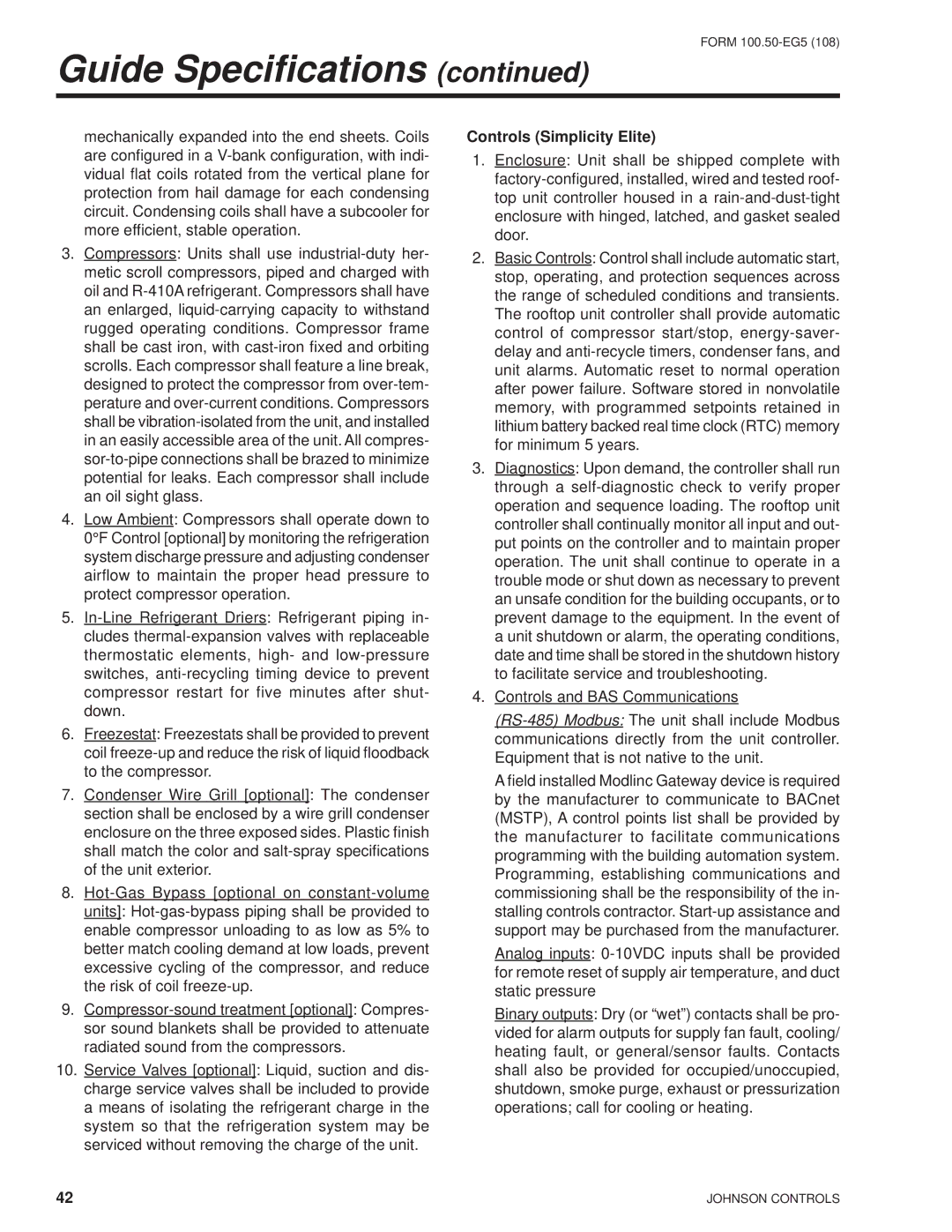mechanically expanded into the end sheets. Coils are configured in a V-bank configuration, with indi- vidual flat coils rotated from the vertical plane for protection from hail damage for each condensing circuit. Condensing coils shall have a subcooler for more efficient, stable operation.
3.Compressors: Units shall use industrial-duty her- metic scroll compressors, piped and charged with oil and R-410A refrigerant. Compressors shall have an enlarged, liquid-carrying capacity to withstand rugged operating conditions. Compressor frame shall be cast iron, with cast-iron fixed and orbiting scrolls. Each compressor shall feature a line break, designed to protect the compressor from over-tem- perature and over-current conditions. Compressors shall be vibration-isolated from the unit, and installed in an easily accessible area of the unit. All compres- sor-to-pipe connections shall be brazed to minimize potential for leaks. Each compressor shall include an oil sight glass.
4.Low Ambient: Compressors shall operate down to 0°F Control [optional] by monitoring the refrigeration system discharge pressure and adjusting condenser airflow to maintain the proper head pressure to protect compressor operation.
5.In-Line Refrigerant Driers: Refrigerant piping in- cludes thermal-expansion valves with replaceable thermostatic elements, high- and low-pressure switches, anti-recycling timing device to prevent compressor restart for five minutes after shut- down.
6.Freezestat: Freezestats shall be provided to prevent coil freeze-up and reduce the risk of liquid floodback to the compressor.
7.Condenser Wire Grill [optional]: The condenser section shall be enclosed by a wire grill condenser enclosure on the three exposed sides. Plastic finish shall match the color and salt-spray specifications of the unit exterior.
8.Hot-Gas Bypass [optional on constant-volume units]: Hot-gas-bypass piping shall be provided to enable compressor unloading to as low as 5% to better match cooling demand at low loads, prevent excessive cycling of the compressor, and reduce the risk of coil freeze-up.
9.Compressor-sound treatment [optional]: Compres- sor sound blankets shall be provided to attenuate radiated sound from the compressors.
10. Service Valves [optional]: Liquid, suction and dis- charge service valves shall be included to provide a means of isolating the refrigerant charge in the system so that the refrigeration system may be serviced without removing the charge of the unit.
Controls (Simplicity Elite)
1.Enclosure: Unit shall be shipped complete with factory-configured, installed, wired and tested roof- top unit controller housed in a rain-and-dust-tight enclosure with hinged, latched, and gasket sealed door.
2.Basic Controls: Control shall include automatic start, stop, operating, and protection sequences across the range of scheduled conditions and transients. The rooftop unit controller shall provide automatic control of compressor start/stop, energy-saver- delay and anti-recycle timers, condenser fans, and unit alarms. Automatic reset to normal operation after power failure. Software stored in nonvolatile memory, with programmed setpoints retained in lithium battery backed real time clock (RTC) memory for minimum 5 years.
3.Diagnostics: Upon demand, the controller shall run through a self-diagnostic check to verify proper operation and sequence loading. The rooftop unit controller shall continually monitor all input and out- put points on the controller and to maintain proper operation. The unit shall continue to operate in a trouble mode or shut down as necessary to prevent an unsafe condition for the building occupants, or to prevent damage to the equipment. In the event of a unit shutdown or alarm, the operating conditions, date and time shall be stored in the shutdown history to facilitate service and troubleshooting.
4.Controls and BAS Communications
(RS-485) Modbus: The unit shall include Modbus communications directly from the unit controller. Equipment that is not native to the unit.
A field installed Modlinc Gateway device is required by the manufacturer to communicate to BACnet (MSTP), A control points list shall be provided by the manufacturer to facilitate communications programming with the building automation system. Programming, establishing communications and commissioning shall be the responsibility of the in- stalling controls contractor. Start-up assistance and support may be purchased from the manufacturer.
Analog inputs: 0-10VDC inputs shall be provided for remote reset of supply air temperature, and duct static pressure
Binary outputs: Dry (or “wet”) contacts shall be pro- vided for alarm outputs for supply fan fault, cooling/ heating fault, or general/sensor faults. Contacts shall also be provided for occupied/unoccupied, shutdown, smoke purge, exhaust or pressurization operations; call for cooling or heating.
